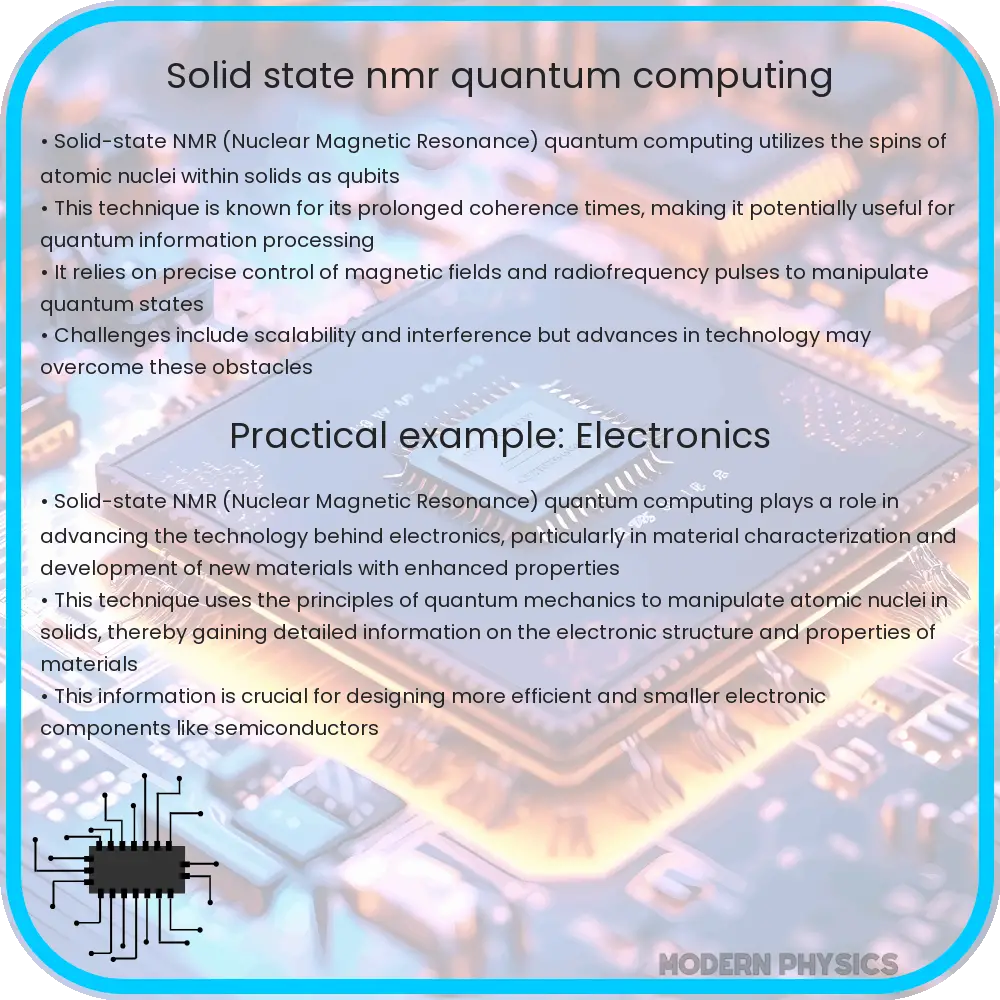Explore the cutting-edge realm of solid-state NMR quantum computing, delving into its cohesion, speed, and precision for transformative computing solutions.

Solid-State NMR Quantum Computing: Unveiling the Future of Computation
Quantum computing represents a monumental leap forward from traditional computing, promising to solve complex problems that are currently beyond the reach of classical computers. Among the various technologies vying to realize this potential, solid-state Nuclear Magnetic Resonance (NMR) quantum computing has emerged as a promising candidate. This innovative approach leverages the principles of nuclear magnetic resonance, a technique commonly used in chemistry and medicine, to control quantum bits (qubits) with unprecedented cohesion, speed, and precision.
The Basics of Solid-State NMR Quantum Computing
At its core, solid-state NMR quantum computing utilizes the nuclear spins of atoms within a solid material as qubits, the fundamental units of quantum information. Unlike traditional bits, which can be either 0 or 1, qubits can exist in multiple states simultaneously thanks to the principle of superposition. This unique property, along with entanglement, allows quantum computers to process vast amounts of information at speeds unattainable by classical computing.
Advantages of Solid-State NMR Techniques
The cohesion, speed, and precision of solid-state NMR quantum computing stem from its unique use of nuclear spins in solid environments. The controlled environment provides several advantages:
- Cohesion: The fixed positions of atoms in a solid matrix ensure stable qubit interactions, reducing decoherence—a major challenge in quantum computing. This stability enhances the cohesion of quantum states, allowing for more reliable computation.
- Speed: Solid-state NMR techniques can manipulate qubits rapidly, thanks to the precise control over nuclear spin interactions. This enables faster gate operations, crucial for executing complex algorithms efficiently.
- Precision: The high level of control over each qubit’s quantum state in solid-state NMR systems allows for precise quantum gate operations. This precision is vital for the accuracy of quantum algorithms and error correction mechanisms.
The application of solid-state NMR in quantum computing also benefits from decades of research and technological advancements in NMR spectroscopy. This background provides a robust foundation for developing sophisticated quantum computing systems that harness the full potential of nuclear spins.
Exploring Solid-State NMR in Quantum Computing
Solid-state Nuclear Magnetic Resonance (NMR) is emerging as a pivotal technology in the realm of quantum computing, offering a unique blend of cohesion, speed, and precision. This article delves into how solid-state NMR underpins the development of quantum computing devices, focusing on its operational mechanisms, advantages, and challenges.
The Cohesion of Quantum Bits
At the heart of quantum computing lies the qubit, a quantum bit that represents the fundamental unit of quantum information. Unlike classical bits, which are strictly binary, qubits can exist in multiple states simultaneously thanks to quantum superposition. Solid-state NMR leverages the nuclear spins of atoms within a solid material to create and manipulate qubits. This method achieves remarkable cohesion among qubits through the controlled interactions of nuclear spins, enabling the execution of complex quantum algorithms.
Enhancing Speed and Precision
The speed at which quantum computations are performed is crucial for the practical application of quantum computers. Solid-state NMR techniques, by manipulating the nuclear spins with high precision, can significantly accelerate quantum operations. Furthermore, the precision of solid-state NMR, guided by advanced pulse sequences and magnetic field controls, ensures that qubit states are accurately manipulated, minimizing errors that could derail quantum computations.
Challenges and Future Directions
Despite its potential, solid-state NMR quantum computing faces several challenges. The foremost issue is scalability, as increasing the number of qubits while maintaining coherence and precision becomes exponentially difficult. Additionally, solid-state NMR systems require extremely low temperatures and high magnetic fields, demanding sophisticated and costly infrastructure.
However, ongoing research is addressing these challenges, with developments in materials science and quantum control algorithms showing promise for more scalable and robust quantum computing platforms. For instance, the use of diamond vacancies and other defect-based qubits offers a pathway to higher scalability and ambient operational temperatures.
Conclusion
Solid-state NMR stands at the forefront of quantum computing technology, offering a unique approach to qubit creation and manipulation. Its ability to foster cohesive quantum states, combined with the speed and precision of quantum operations, highlights its potential in advancing quantum computing. Despite the challenges, the continuous evolution in NMR techniques and materials science heralds a promising future for solid-state NMR in quantum computing. As the field progresses, it will not only enhance computational capacities but also unlock new possibilities in cryptography, material science, and beyond, marking a significant leap forward in the exploration of quantum phenomena.
